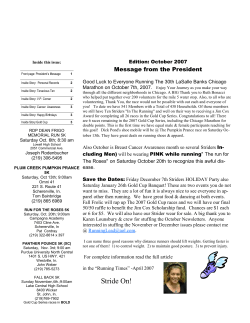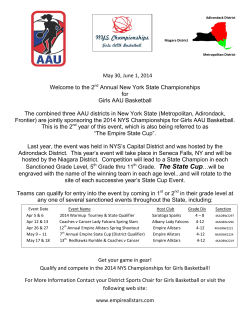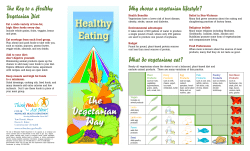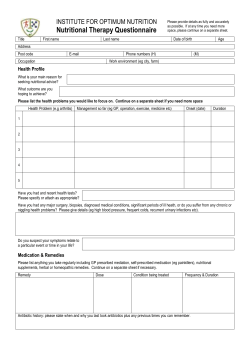
Proper Letter Formation Discover Writing Success™ TEACHER EDITION
TEACHER EDITION Discover Writing Success™ Proper Letter Formation This month we will teach/review proper letter formation to start good habits for kindergartener’s or reinforce proper letter formation for 1st and 2nd graders (3rd graders can use the same concepts with learning cursive letter formation). Continue to keep an eye on proper pencil grasp. For those kids who have been using the Grotto Grip® since January, you may let them try writing without it for a couple days this month. If they are able to maintain the proper grasp (tripod grasp) throughout their writing assignments and you don’t see them slipping into old habits, they may no longer need it. If you see the child’s hand fatiguing and old habits slipping in during the writing assignments, leave the grip on for another month or longer if needed and let the parents know to continue the activities from January to strengthen the hand. The pace at which you introduce/review letters this month will differ depending on grade and student skill level. Thus, the pace will not be dictated, however supporting activities will be provided to enhance the learning of proper letter formation. Capital Letter Stories™ and Lowercase Letter Stories™ are two excellent resources for teaching/learning proper letter formation. It is suggested that each child be provided with an individual workbook so that practice can be carried over from the classroom to the home. Just as children are sent home with reading logs, they should be sent home with 5 minutes of writing homework each night to reinforce good habits. If the mechanics of writing are performed fluently (with speed and accuracy) and with ease, the child is free to think of the content, grammar and spelling, which will lead to more mature written work. www.pathwaysforlearning.com © 2009 Pathways for Learning Products, Incorporated. All Rights Reserved. “GROTTO GRIP” is a registered Trademark of Pathways for Learning Products, Incorporated, Charlotte NC. “Discover Writing Success™ “is a Trademarks of Pathways for Learning Products, Incorporated, Charlotte NC. “Letter Stories” is a trademark of the MeadWestvaco Corporation. Discover Writing Success™ •Teach letters the same way each time •Give a verbal plan (story) along with the formation to increase retention •Use a multisensory approach -spend time forming pre-writing shapes and letters/numbers in various tactile media •Have the child practice letter formation daily •Pick 1-5 letters (depending on developmental level of child) and have them write each letter 5X in a handwriting journal each day Kindergarteners should begin with Capital Letter Stories™, 1st grade could review both Capital Letter Stories ™ and Lowercase Letter Stories™, and 2nd grade could review just Lowercase Letter Stories™. For kindergarteners who haven’t yet developed letter identification, continue to address those skills before beginning letter formation. These kids would benefit from continued activities to address pre-writing shapes and visual discrimination as well as letter identification. Attempting letter formation activities without the pre-requisite skill of recognition results in: drawing rather than writing letters, poor uniformity in letter formation (make it different every time), poor retention for motor patterns. Pathways for Learning’s Philosophy for Handwriting Instruction •When teaching handwriting, spend 10/20 minutes on pre-writing activities and 5/10 minutes on actual letter formation. •Quality is better than quantity – writing 5 letters correctly is better than writing 20 sloppy letters! •Have parents encourage proper writing grasp and writing posture table top •Knees and hips are flexed at 90 degrees and feet are flat on floor. Tabletop is approximately 2 inches above the child’s bent elbow. •Do not expect proper spacing between letters and words too early! On average, the skills needed for proper spacing do not come in until 7 years, 5 months (range 6:5-8:5 would be considered within normal limits) We need to facilitate spacing with cues and/or specialized paper (RediSpace® Transitional Notebook Paper for Grades 1.5 and up) Get Started! 1.Begin with a warm-up activity (finger strength or dexterity, multi-sensory activity) 2.Review any letters from previous days 3.Introduce the new letter(s) and read the story that goes along with the new letter(s). 4.Send home a 5 minute writing assignment to reinforce the daily lesson. Page 2 www.pathwaysforlearning.com © 2009 Pathways for Learning Products, Incorporated. All Rights Reserved. “Discover Writing Success™ “is a Trademarks of Pathways for Learning Products, Incorporated, Charlotte NC. “Letter Stories” is a trademark of the MeadWestvaco Corporation. Discover Writing Success™ Week 1 – Provide: Nuts and bolts, a piece of play dough and a model of the letter(s) for the day. Have the children rotate the nut on and off a few times using their thumb and pointer finger only (not by moving their wrist or simply spinning it on/off with one finger). Next, encourage the kids to roll the play dough into long snakes. Demonstrate placing the play dough on the table or on the piece of wax paper in the correct sequence for forming that letter then ask the kids to do the same. Have the children trace the letter with the proper formation while reciting the letter story (Let’s make an I. Draw the Firefighter straight and tall. Put the hat on the Firefighter. Put the boots on the Firefighter.) Practice forming the letter(s) in the workbook (only one line of practice per day—not the whole worksheet!) Remember, quality is better than quantity! Week 2 – Wikki Stix warm-up Provide: Pop beads, Wikki Stix and a model of the letter(s) of the day. Have the children pop 10 pop beads together using only the tips of their thumb, pointer and ring fingers (the tripod fingers) as fast as they can! You can vary this activity by having the children place their hands under the table and pop the pop beads together without looking to develop better fine motor awareness. Demonstrate placing the wikki stix on the table or better even on a vertical surface (have the kids at walls or cabinets). Demonstrate placing the Wikki Stix® in the correct sequence for the formation of the new letter(s). Week 3 – Provide: tissue paper or crate paper and paper model of the letter (s) Demonstrate using a square of paper. Place it in the palm of the writing hand. Have the students try to crumple the paper into a small ball using only one hand (remind the children not to use the table, their body or their other hand to help). Make several balls to strengthen the palmar muscles to support free finger movement. Next, have the children glue the balls on the paper in the correct sequence for forming the new letter(s). Practice forming the letter(s) in the workbook. Practice forming the letter(s) in the workbook. Page 3 www.pathwaysforlearning.com © 2009 Pathways for Learning Products, Incorporated. All Rights Reserved. “Discover Writing Success™ “is a Trademarks of Pathways for Learning Products, Incorporated, Charlotte NC. © 2009 MWV. “WIKKI STIX” is a registered Trademark of Omnicor, Inc. Phoenix AZ. U.S. Patent 4273537 Discover Writing Success™ Week 4 – Provide: Styrofoam cup with letters written randomly on cup, (draw a line along the bottom, around the circumference of the circle), multi-colored chalk pieces, and a chalkboard slate. For kindergarten and some 1st grade classes, letter formation will continue into May. Here are some warm-up activities to continue reinforcing proper letter formation: Demonstrate holding the cup with all fingers and thumb of the writing hand on the line at the bottom of the cup (palm should be facing up and cup should remain upright – not tilted). Have the children use their fingers (not their wrist) to rotate the cup to find a letter, and then turn the cup the opposite direction to find the next letter. Activities could be: •Glue small pom-poms in the correct formation sequence to a piece of paper with the letter(s) written large in the center (approximately 6-inches tall or more). •Finding the letters in alphabetical order •Finding the letters in alphabetical order and reciting a word that begins with that letter •Finding the letters in the order of spelling words •Write the new letter(s) on fine grain sand paper and ask the kids to trace their finger over it in the correct sequence for formation. •Write/trace the letter(s) using vibrating pens •Write the letters in shaving cream Practice the letters with proper formation on the chalkboard slate. Have the children trace over the letter in the correct sequence with various pieces of chalk to make a “rainbow letter”. Practice forming the letter(s) in the workbook. Page 4 www.pathwaysforlearning.com © 2009 Pathways for Learning Products, Incorporated. All Rights Reserved.“Discover Writing Success™ “is a Trademarks of Pathways for Learning Products, Incorporated, Charlotte NC.
© Copyright 2025





















